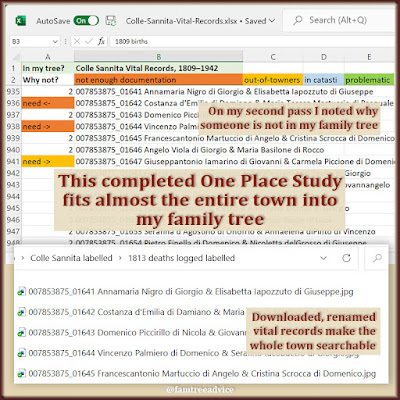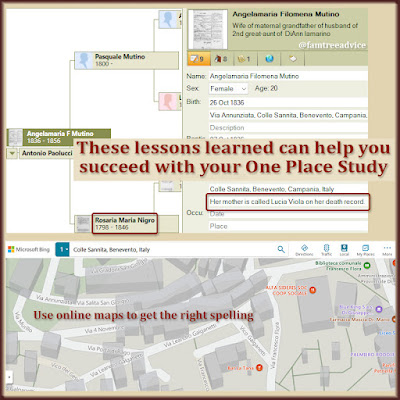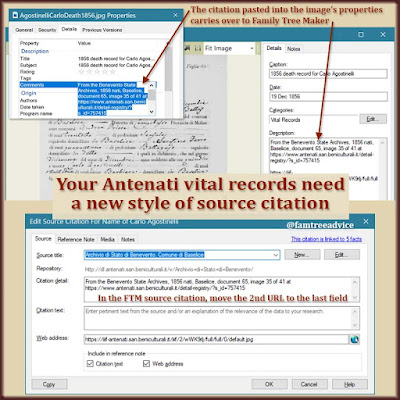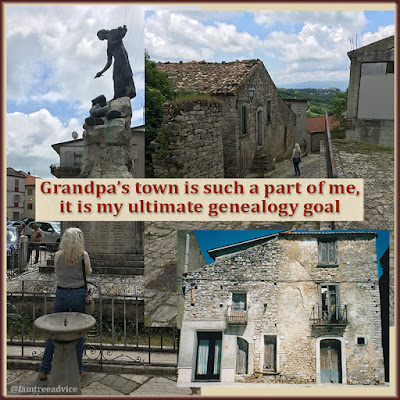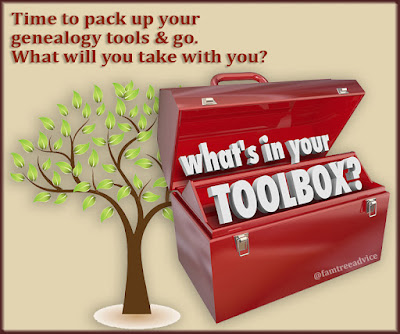JULY 2025 UPDATE: Unfortunately, the Antenati website has made it impossible to use this technique anymore. They are not giving us access to the directory where the full-size images are housed.
Remember the good old days when you could download an entire town's vital records from Antenati? I'm glad I grabbed all my main ancestral hometowns while I had the chance. But there are still more vital record collections I'd love to have at my fingertips.
Both the Italian Antenati website and FamilySearch block the use of mass-download programs. They may be trying to avoid taxing their web servers. But it could be in their contract with the localities to prevent these activities. There's nothing we users can do about it.
While mass downloads are gone, we can do…let's call them "group downloads." I've heard from enough readers to know that the desire to collect these groups of files is there. That's why I want to share my semi-automated process for downloading Antenati files.
 |
| Done in batches, this process lets you download as many Antenati vital record images as you want. |
Granted, if the register book you want has tons of pages, this will be an ordeal. It may scare you away, or you may decide to tackle it over the course of a few days. But, if the book you want is small enough, you'll absolutely want to do this.
Some of my ancestors came from an Italian town with a handful of frazioni. A frazione is like a hamlet—a semi-independent part of a town. Think of a large city like Brooklyn, New York. It's many residential sections each have their own identity. There's Bushwick, Bedford-Stuyvesant, and Liberty Park. These sections are a lot like frazioni in Italy. (Note: The plural of frazione is frazioni.)
Some of the people in my family tree have birth records I'm missing because they came from a frazione of the town. I want to gather the records from the frazioni I'm missing.
Montorso is a frazione with 5 birth registers available on Antenati (1862–1866). In later years, they stored their vital records with the larger town. That's how some people born in Montorso made it into my family tree. The Montorso registers are very small, so I'm going to download all the files.
The 1866 birth register has 6 images, but only 3 contain birth records. The others are the book cover, title page, and a blank page at the end of the book. I want images 3, 4, and 5.
Let's Get Started
Here's the process, and it's the only way to get to the high-resolution images:
- Go to each image you want to download and copy its URL to a text file on your computer. The URL changes the instant you click a new page, even if the image doesn't render right away.
- In this case, the URLs are:
- https://antenati.cultura.gov.it/ark:/12657/an_ua2286280/02R93aK
- https://antenati.cultura.gov.it/ark:/12657/an_ua2286280/5gGRdap
- https://antenati.cultura.gov.it/ark:/12657/an_ua2286280/LPa47oY
- In this case, the URLs are:
- The last 7 characters of each URL on Antenati, the part after the last /, is a code that's unique to that image. Your goal: Put that code in the following template, replacing the word TARGET: https://iiif-antenati.san.beniculturali.it/iiif/2/TARGET/full/full/0/default.jpg
The result is this:- https://iiif-antenati.san.beniculturali.it/iiif/2/02R93aK/full/full/0/default.jpg
- https://iiif-antenati.san.beniculturali.it/iiif/2/5gGRdap/full/full/0/default.jpg
- https://iiif-antenati.san.beniculturali.it/iiif/2/LPa47oY/full/full/0/default.jpg
- Click each new link (or paste it into a web browser), give it a moment to display, then right-click and save the image to your computer.
When you create a longer list of image URLs from the same register book, you can complete this task with a more automated process:
- In your text editor, Find & Replace everything before the unique 7-character code with https://iiif-antenati.san.beniculturali.it/iiif/2/ (that's the first part of the template URL). You can do this to the entire list at once because each URL has the same beginning.
- Paste /full/full/0/default.jpg at the end of each line in your list (that's the end of the template URL). Take a look at the image at the top of this article to see the before and after text files.
 |
| There's no download button on Antenati, but here's a download process you can use over and over. |
I use a free Windows text editor called Notepad++ (get it at https://notepad-plus-plus.org). As a retired website manager, I used to work in HTML code every day. I still HTML-code these blog articles and my own website. Notepad++ has always saved me tons of time and ensured my accuracy.
A big Notepad++ benefit for this project is that any URL in a text file is a clickable link. When you make a list of URLs, it's easy to click through them, go to the browser page, and right-click to save the file. Be sure to give each file you download a different name:
- First, create a folder for the town. In this case, Montorso.
- Then make a sub-folder for the year and type of document, such as 1866 births.
- When you right-click the high-resolution images in your web browser, save them as 1.jpg, 2.jpg, 3.jpg. This keeps the files in the proper order for you.
Yes, this is tedious for a large town and nearly unthinkable for a big city. But if the town's vital records are important to your research, you'll be happy you went to the trouble. Be sure to take breaks or your mousing arm will get sore!
When I prepared to download the 1865 birth records for Montorso, I saw that the register has 21 images. But looking at the thumbnail images, I found that I needed to download only 12 of them. The rest were cover pages and blank pages. Keep an eye out for duplicate images, too. When this happens, you can decide which one is better and skip the other.
When you have a whole collection at your fingertips, you'll make new discoveries. Like, your 2nd great grandmother and her first cousin were born the same day. Or your great grandmother was a twin and you didn't know it! (That happened to me.)
If you have Italian ancestry and you're not using the Antenati website, you probably haven't gotten very far. Find out exactly how the use the Antenati with these articles:
